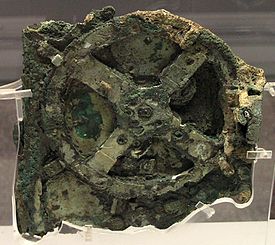
Decades of meticulous investigation have revealed many features of the 1st Century BC Antikythera Mechanism, a portable planetarium that demonstrated the motion of celestial objects. But we must question researchers’ conclusion that the Mechanism incorrectly represented the orbit of Mars, in particular, by roughly 30 degrees during retrograde motion1.
This discrepancy seems anomalous in a sophisticated device that otherwise exhibited a much smaller range of error. So maybe there is some other explanation.
In fact, such an explanation is not far to seek. Researchers on the Mechanism appear committed to a uniformitarian view that assumes that ancient planetary orbits were identical to modern ones. But there is plenty of evidence that the orbits of Mars and Venus, and to a lesser extent of Earth and Moon, had been disrupted during the Bronze Age Catastrophes. The original version of this theory was put forth by Immanuel Velikovsky in his Worlds in Collision2. Now a Revised Venus Theory corrects key mistakes in the original theory and adds an array of new supportive evidence.
According to the theory, the approaches of Venus and then Mars that caused the Catastrophes ceased in the 8th Century BC. But clearly it took many centuries thereafter for the planets to move to orbits resembling their modern ones. Thus we should expect the Antikythera Mechanism to reflect the orbits as they were around 200 or 100 BC–after shifting part way to their modern configurations.
When experts examined the front cover inscription, they found: “For Venus, the inscription gives 224 days for the intervals between the superior conjunction and the greatest elongations, and 68 days for the remaining intervals between the greatest elongations and the inferior conjunction; computation using an accurate ratio from modern theory yields 221 days and 71 days, respectively. For Mars, the inscription’s 349 days between conjunction and the stations and 82 days for the retrogradation between the stations agrees well with the accurate values, 354 and 72 days. For Jupiter, the inscription’s 139 days between conjunction and the stations agrees to the day with accurate computation.” (Jones, p. 198) Not surprising that Jupiter’s was the only orbit that is the same as its modern form, because Jupiter was little affected by the Bronze Age disruption. But also not surprising that Venus’ and Mars’ orbits showed such divergence from modern computation. Venus and Mars were the two planets most deeply involved in the disruption of the Bronze Age, and only gradually were their orbits moving toward their modern configurations at the time the Mechanism was constructed.
Data from the period relations of Venus over time are consistent with this interpretation. For the period of perhaps 200-80 BC, we have readings (Jones, p. 228) of 1.59861 from the Antikythera Mechanism and 1.59861 from the Astronomical Cuneiform Texts. For around AD 150, we have Ptolemy’s figure of 1.59869, and for AD 2000 1.59873. In other words, there is a trend toward the present value, as we would expect, while the parallel readings for Saturn remain constant.
Consistent with this is the finding that Tycho Brahe’s orbit of Mars around AD 1600 has 5% greater eccentricity than the modern estimate.3
The Antikythera Mechanism and the ancient astronomers were right about planetary orbits. And the Revised Venus Theory provides an agenda for further investigation.
*****
Kenneth J. Dillon is an historian who writes on science, medicine, and history. See the biosketch at About Us. For further information on the Revised Venus Theory, see his The Knowable Past (2nd edition, Washington, D.C.: Scientia Press, 2019), also available on Amazon.com.
